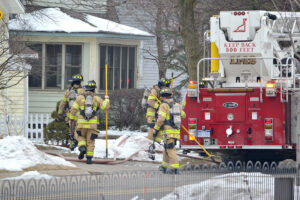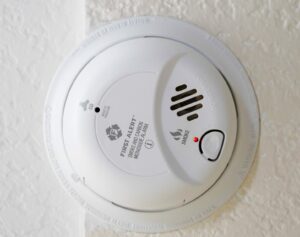By Nance Ebert, Contributing Writer

REGION – Maximizing home fire safety is crucial for anyone but can be extremely challenging for older adults. Those living independently at home or in an assisted residential setting should be mindful of fire safety tips and how they can be implemented.
Being prepared ahead of time with an exit strategy can make a world of difference and in some extreme instances, the difference between life and death. “More people are injured or die in fires at home than anywhere else,” said Jake Wark, public information officer for the Mass. Department of Fire Services. “Older adults face a disproportionate risk, especially when they’re living in a family home with smoke alarms that haven’t been maintained in many years.”
Ensure detectors work and are up-to-date
First, it is important to have functioning smoke detectors installed on every level of your home and in bedrooms. “Modern alarms have a manufacturing date printed on the back,” Wark explained. “Smoke alarms should be replaced after ten years and carbon monoxide alarms should be replaced after five to seven years, depending on the model. If the alarm is still in its useful lifespan and takes alkaline batteries, change the batteries twice a year when you change your clocks.”

“If it’s time for a new alarm, choose one with a sealed, long-life battery and a hush feature,” Wark added. “You won’t have to change the batteries for ten years and you can silence the alarm if you burn toast. Whatever type of alarms you have, test them every month to be sure you’re protected.”
The task of replacing these important, life-saving measures can be daunting for an older person. Many fire departments, including the town of Hudson, can help through their Senior SAFE programs.
It is also a good idea to have a fire extinguisher as well as an escape ladder readily accessible if a second story of the home exists. Practicing an escape route ahead of time when things are calm and you can think clearly will help give a sense of confidence to safely escape in the event that a real fire is present.
Kitchen safety
Since many house fires start in the kitchen, being mindful not to leave food cooking on the stove when you are going to another part of the home is important. The kitchen is the perfect place to keep a fire extinguisher on hand and make sure to read the instructions after purchasing it and not in the heat of the moment, (literally) once a real fire is present.
Any older appliances with fraying cords or damaged plugs should be replaced. This will help to avoid shocks or any sparks that can occur. Many people love the convenience of using a slow cooker or crockpot, however, it’s recommended that you be present in the home while this appliance is plugged in. In the event of a mishap, it can be addressed quickly.
During the winter months, the risk of fire tends to escalate. This might be due to the fact that people are using decorative candles, smoking indoors, adding extra space heaters for additional warmth, and using fireplaces. Flameless candles are a great option for those looking to bring a warm glow to a room without the risk of fire.
Considerations for older people
The Department of Fire Services offers materials to seniors about fire safety tips at home and how to plan for emergencies through its website.
“The fire and injury risks we face change as we age and it is important to adapt our homes so we can stay independent and safe,” Wark noted. “A fall, a burn or a fire can be devastating. As our skin ages, it thins, and burns can be more damaging more quickly.”
“People facing mobility issues may need to revise their home escape plan to accommodate that, by perhaps moving a bedroom to the first floor,” he added. “People with hearing issues may want to get a bed shaker connected to their smoke alarm.”
If there is someone in the dwelling who needs immediate assistance, it is a good idea to place a large, visible sticker in that window. This helps to alert firefighters in case of an emergency. This can include rooms that children or older adults occupy or someone who might be physically challenged.
The National Fire Protection Association has a wealth of information and online resources on fire, electrical and related hazards on its website. It also has short video clips that are very informative.
“We go on many calls for fire alarms in a senior-specific building and the residents don’t know what it is and they stay inside the building rather than evacuate,” said Brian Sleeper, Hudson’s Deputy Fire Chief and Assistant Emergency Management Director. “If they can at least get to a safer location, that can make a huge difference with the outcome. It’s when people become complacent that we end up having a tragedy.”
For more information:
https://www.mass.gov/orgs/department-of-fire-services
RELATED CONTENT:
Everyday Heroes (fiftyplusadvocate.com)
Important steps to avoid a house fire and stay safe – Fifty Plus Advocate












